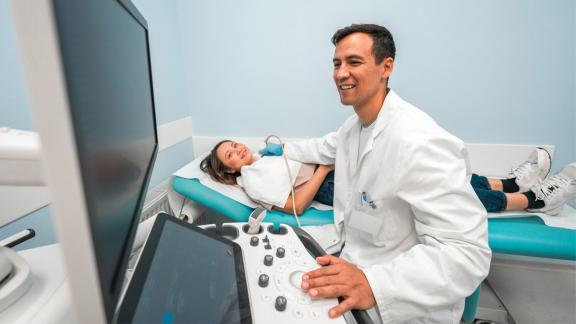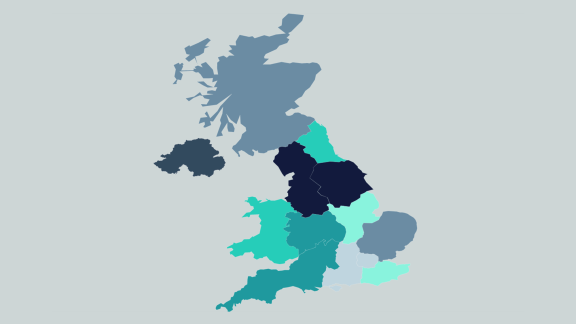Sonography and the regulation of workforce

Sonographers have previously been taught medical ultrasound at postgraduate level in the United Kingdom (UK). Many sonographers have a healthcare background in, for example, diagnostic radiography, nursing or midwifery. Developments in direct entry postgraduate and undergraduate ultrasound education have enabled non-healthcare professionals to enter the sonographer workforce. This includes the approval of an integrated BSc (Hons) apprenticeship in sonography by the Institute for Apprenticeships and Technical Education.
Most ultrasound programmes in the UK are accredited by the Consortium for the Accreditation of Sonographic Education (CASE). A programme typically lasts between 12 and 24 months, and leads to a postgraduate certificate (PgC), diploma (PgD) or MSc. Programmes leading to a BSc (Hons) award typically take three years. There are approximately 18 Higher Education Institutions offering CASE accredited ultrasound programmes in the UK.
Many sonographers working in the UK are educated and trained overseas. There is no comparative list of ultrasound qualifications from around the world available and clinical practice and education in other countries may vary from that in the UK. Employers must make their own assessment of competency.
The title of sonographer is not legally protected. These newer entry methods into the sonography workforce alongside recruitment of sonographers who originally trained overseas add to the existing complexity around sonographer regulation. Many sonographers are statutorily registered as they originally trained for example as a diagnostic radiographer, nurse or midwife but through no fault of their own statutory registration is not possible for all sonographers.
What this means in practice for employers
When recruiting to sonographer vacancies, it is important for employers to carefully consider their registration requirements.
Many employers prefer their sonographers to be statutorily registered i.e. as a radiographer with the HCPC, or nurse/midwife with the Nursing and Midwifery Council (NMC) and this is a local decision. It is fair to expect individuals who are able to register with a regulatory body such as the HCPC or NMC to do so, however, we would urge employers to consider that for some otherwise well qualified sonographers who have trained from different professional backgrounds where regulation doesn't exist or who are direct entrants into sonography training, statutory registration is not possible. By insisting on statutory registration you could be further limiting your pool of candidates in what is recognised as a shortage specialty by the UK Government Migration Advisory Committee. It should also be recognised that being on a statutory register for example, HCPC as a radiographer, does not offer any assurance of ultrasound qualifications or competency. Guidance has been published to assist with this process by the Society of Radiographers and British Medical Ultrasound Society.
When considering your registration requirements for a sonography position, please be aware that there are some legal restrictions for sonographers who are not statutorily registered, which prevent them carrying out elements of a role:
- Sonographers who are not statutorily registered cannot act under Patient Group Directions for the administration of drugs and medicines, or train to become supplementary prescribers. They are allowed to act under Patient Specific Directions but those requiring them to do so must ensure their competence.
- Sonographers who are not also statutorily registered cannot act as a referrer for clinical imaging examinations involving the use of ionising radiation.
Voluntary registration
Sonographers may apply to be registered on the Professional Standards Authority accredited (voluntary) Register of Clinical Technologists (RCT). Those with a CASE accredited UK qualification can apply via the primary route. All other sonographers would need to apply via the equivalence route.
NHS Jobs
When posting adverts for sonographer vacancies on the NHS Jobs service consider your use of the pre-application filtering question for registration. This question will automatically prevent otherwise well qualified sonographers for whom statutory registration is not possible from applying to your vacancy.
Employment and workforce practices
There are several areas where employers can provide assurance of the competency of their workforce.
- Recruitment - clear expectations and the use of NHS Employment Check Standards in addition to recruiting for values and behaviours.
- Preceptorship – provide structured support in the initial stages of employment.
- Supervision - ensure appropriate supervision of individuals where it is required.
- Continuing Professional Development - ensure staff continue to meet the professional requirements of their role and are up to date in their practice.
- Clear standards, expectations and boundaries - ensure appropriate delegation so that individuals do not operate outside of their competence.
- Effective appraisal - embed organisational values and behaviours into individual objectives.
- Policies - embed into day to day practice and support staff to challenge issues of concern appropriately.
- Audit of clinical practice – to identify area for further development.
Related resources
- Conducting HR matters virtually.
- Society of Radiographers information on sonographer training, employment, registration and professional indemnity insurance.
- Society of Radiographers and British Medical Ultrasound: Society Guidelines for Professional Ultrasound Practice (PDF).
- Society of Radiographers and British Medical Ultrasound Society: Recruitment of sonographers without a CASE accredited award.



